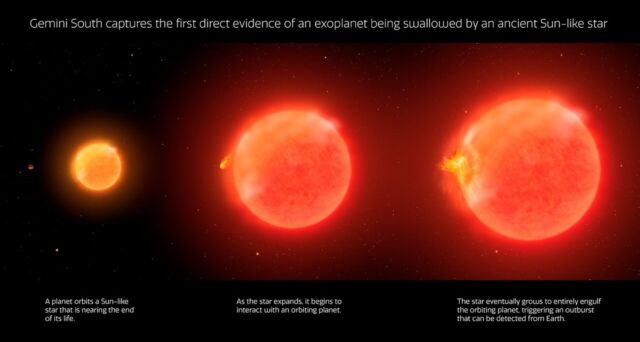

Caught in the act: Astronomers spot star swallowing a planet for first time
source link: https://arstechnica.com/science/2023/05/watch-a-distant-death-star-devour-a-gas-giant-planet-in-one-big-gulp/
Go to the source link to view the article. You can view the picture content, updated content and better typesetting reading experience. If the link is broken, please click the button below to view the snapshot at that time.
"That's no moon..." —
Caught in the act: Astronomers spot star swallowing a planet for first time
A sneak peek at Earth's eventual fate.
Jennifer Ouellette - 5/3/2023, 3:17 PM
Roughly 5 billion years from now, our Sun will end, not with a bang but with a whimper. That's when it finally burns through all the fuel in its core and puffs outward into a red giant, swallowing all the inner planets of our Solar System in the process, including Earth. But no star has ever been caught in the act of gulping down a planet this way—until now. Astronomers have spotted a white-hot flash from a distant star in our Milky Way galaxy and concluded that it came from the final stage of this process, according to a new paper published in the journal Nature. Yes, it's a literal "Death Star," announced on the eve of Star Wars Day (May 4).
Like all stars, our Sun is a giant nuclear reactor, made up of hydrogen and helium gas. To produce light, it converts hydrogen into helium through fusion reactions, and that energy pushes back against the crushing weight of its outer layers. When all the hydrogen is turned into helium, the Sun will no longer generate sufficient energy to counteract the pull of gravity. The core will contract inward, heating up the interior to sufficient temperatures to fuse helium into carbon. Hydrogen fusion will migrate to the outer layers. The Sun will puff outward and turn into a red giant, expanding those outer layers as the core collapses. The outer layers will engulf the nearest planets, including Earth, which will plunge into the core and be vaporized, triggering an outburst of energy and matter. The Sun will continue to burn for a few more billion years before it ultimately cools into a black dwarf star.
AdvertisementThis process only occurs a few times a year in the Milky Way. Astronomers have observed the early stages of the process (planets so close to their host stars that they will inevitably be engulfed when those stars expand) along with the aftermath of this stellar evolution (when the stars have puffed up and seem to have peculiar properties, such as their rotational speed or chemical composition). But scientists have never witnessed the actual devouring. That's what makes this discovery so exciting, according to co-author Kishalay De, an MIT postdoc: This is the first direct evidence of a crucial stage of stellar evolution.
"This has been one of the fundamental predictions of our understanding of stars and their surrounding planets," De said during a media briefing. Of course, astronomers aren't "seeing" the event in the way that term is typically understood, per De. The star in question, dubbed ZTF SLRN-2020, is 10,000 light-years away in the constellation Aquila, too far away to see the star and its planet separately, so scientists are actually observing the effects that gobbling up the planet had on the star in pixel-level data.
De was poring over data from the Zwicky Transit Facility (ZTF) at the Palomar Observatory in California about three years ago, hunting for the telltale brightening (by a factor of a few thousand times over the course of a week) that marks a nova. Such explosions occur when a white dwarf steals matter from a companion star. De spotted a star brightening by a factor of a few hundred times for a couple of weeks. He quickly checked out observations of the same star taken by the Keck Observatory in Hawaii. But the spectrum revealed that the composition and temperature of the gas surrounding this star was nothing like a nova. "This source appeared to be surrounded by a bunch of cold gas," De said. "We were seeing signs of molecules that can only exist at cold temperatures."
AdvertisementThe best way to get a better look at the cold gas was to view the system in the infrared spectrum, so De turned to observational data from the Palomar Observatory's infrared camera, as well as archival data collected by NASA's NEOWISE telescope, which images the night sky in the infrared every six months. That data showed that even after the optical light had faded, there was still a strong infrared glow from all that cold dust. Nine months before the brightening, NEOWISE had picked up an infrared glow from dust in the system. And data from the Gemini South Telescope provided high-resolution observations enabling De et al. to pinpoint the location of the outburst, as well as measurements of the star's brightness over time, free of contaminating data from nearby stars.
All that data gave De three key pieces of evidence: cold gas detected in the outburst, dust formed after the outburst giving off an infrared glow, and an infrared brightening several months before the outburst. De thought it must be the signature of two stars merging, but the event was 100 to 1,000 times fainter than any known merger. So whatever ZTF SLRN-2020 swallowed had to be something a thousand times less massive than the star, based on what is currently known about stellar dynamics. The most likely object was a planet: a gas giant roughly the size of Jupiter.
Page:
Recommend
About Joyk
Aggregate valuable and interesting links.
Joyk means Joy of geeK
